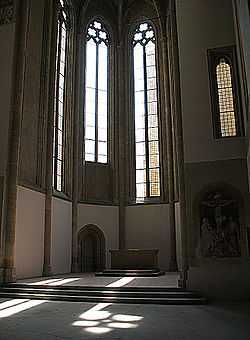Santa Maria Donna Regina Vecchia

Santa Donna Regina Vecchia is a church in Naples, in southern Italy. It is called Vecchia ("old") to distinguish it from the newer and adjacent church of Santa Maria Donna Regina Nuova.
The earliest mention of a church on this site is from the year 780 in a reference to the nuns of the church of San Pietro del Monte di Donna Regina. At that time, the church was quite near the old eastern city wall. The nuns were of the Basilian order and, when that order left Naples in the beginning of the 9th century, took Benedictine vows. In 1264, Pope Gregory IX gave the nuns permission to join the Franciscan order.
In 1293 a severe earthquake caused great damage to the original structure, and queen Mary of Hungary, consort of the king of Naples, Charles II of Anjou financed the construction of a new complex adjacent to the old one. The newer complex is known as Santa Maria Donna Regina Nuova.[1]
Overview
The interior has a nave with wooden Trusses, according to the Franciscan style.
The main artwork in the interior is the sepulchre of Mary of Hungary, commissioned by his son Robert I of Anjou from Tino da Camaino (who had been in Naples since 1324) and another Neapolitan artist. It is located in the left aisle and portrays the queen lying with a Franciscan habit, sustained by the four Virtues, with two Angels opening curtains to show her. The sarcophagus has four small niches with columns and agival arches containing statues of the queen's sons, including Charles Martel, Louis of Toulouse and Robert himself. It has also a decoration in azure mosaics.
Also notable are the 14th-century frescoes by Pietro Cavallini (along with his workshop, or some of his followers) and Filippo Rusuti, one of the most important pieces of paintings from that century in Naples. They were executed between 1307 and 1320 and depict, on two levels, stories of life of Christ and the Apostles. In the lower level are 17 episodes of Jesus, 5 of St. Elizabeth and four of St. Clare, paired to a Last Judgement, the latter certainly attributable to Cavallini. In the upper one are six scenes of St. Agnes. From the same period, but by unknown artists, are the Crucifixion frescoes on the left wall and the Annunciation on the wall facing the entrance.
The triumphal arch of the apse has two frescoes with the Crucifixion; the apse has remains of majolica-covered pavement from a Neapolitan workshop of the Angevin era (late 14th-early 15th century). Also present is a Martyrdom of St. Ursula attributed to Francesco da Tolentino (1520).
Notes
- ↑ All information is from Sopraintendenza per i beni artistici e culturali (1993). Napoli Sacra. Naples: Elio di Rosa.
Sources
- Bologna, Ferdinando (1969). I pittori alla corte angioina di Napoli (1266-1414). Rome.
- Carelli, E.; Casiello, S. (1975). Santa Maria di Donnaregina a Napoli. Naples.
External links
| Wikimedia Commons has media related to Chiesa di Donnaregina Vecchia. |
·